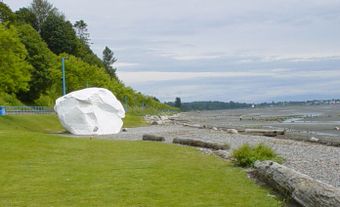Every city has a few streets that stand out above the rest. Perhaps they’re a shopping haven, like Vancouver’s Robson Street, or lined with landmarks, like Ottawa’s Sussex Drive. Other roads earned their fame as the site of a rebellion or a gold rush. Below is a list of ten of Canada’s most iconic streets, but there are many more. What street tells the story of your city?
Robson Street, Vancouver, British Columbia
Now a shopping district, Robson Street was created in the 1890s. A predominance of European specialty shops and restaurants flourished, beginning in the 1950s. Locals and tourist information began referring to it as “Robsonstrasse” — strasse being the German word for street. Its popularity eventually led to gentrification, with chain and (later) high-end stores overtaking independent businesses.
Cariboo Road, British Columbia
The Cariboo Gold Rush attracted masses of hopeful prospectors to the Colony of British Columbia’s remote Cariboo Mountains. The route to the gold fields was only wide enough for one mule, making it hard to get anything into or out of the remote location.
Governor James Douglas ordered the construction of Cariboo Road, a 650 km route from Yale to Barkerville. The road and other costs racked up a debt for the colony. As the gold rush neared its end, the Colony of British Columbia was forced to unite with the Colony of Vancouver Island. (See also Politics in British Columbia.)
Jasper Avenue, Edmonton, Alberta
Jasper Avenue became Edmonton’s commercial hub in the 1870s. But like many of Canada’s main streets, its viability was hurt by indoor shopping malls. Free parking, longer hours and climate control regularly won out. Particularly harmful to Jasper Avenue was the massive West Edmonton Mall, which was once the largest shopping centre in the world.
To try and attract people back downtown, Edmonton narrowed the street, widened sidewalks and added landscaping. The “reimagined” street opened in October 2021.
Portage Avenue, Winnipeg, Manitoba
In 1841, the District of Assiniboia’s government decided to widen the streets near the confluence of the Red and Assiniboine rivers (see also The Forks). They eventually made some existing streets, like Portage Avenue, two chains (40 m) wide, double the standard width. Massive streets helped those with Red River carts to pass through. Unintentionally, it also allowed thousands to gather during the 1919 general strike.
While Portage and Main is one of the most iconic intersections in the country, it’s also one of the quirkiest. Since 1979, the only way to cross the street is through an underground shopping concourse. The intersection is complete with concrete barriers preventing pedestrians from entering the intersection on foot. The intersection is planned to reopen for pedestrians on 1 July 2025, which has raised some concerns amongst the businesses that rent space in the underground shopping concourse.
Yonge Street, Toronto, Ontario
Contrary to popular belief, this Toronto artery isn’t the longest street in the world. It is, however, notable in other ways.
Yonge Street was completed in 1796, to help the British defend Upper Canada from the Americans. Running perfectly straight, it set the standard for the downtown grid. A few decades later, it hosted the Battle of Montgomery’s Tavern, during the 1837 Rebellion of Upper Canada.
Yonge Street eventually turned into a retail and entertainment area, with the massive T. Eaton Company department store (1882), the Toronto Arcade (1884) and the Elgin and Winter Garden Theatres (1913-14).
Sussex Drive, Ottawa, Ontario
Even if you’ve never been to Ottawa, you likely recognize the name Sussex Drive. Running parallel to the Ottawa River, the road begins near the former village of New Edinburgh. Its most famous residents are the Prime Minister of Canada (24 Sussex Drive) and the Governor General of Canada (Rideau Hall). The street is also home to many institutions — like the National Research Council, Royal Canadian Mint and National Gallery of Canada — as well as foreign embassies belonging to the United States, France, Japan, Kuwait, Saudi Arabia and South Africa. The historic ByWard Market, established in 1826, is near the end of the route.
Saint Laurent Boulevard, Montreal, Quebec
Near the center of Montreal, Saint Laurent Boulevard is known as “La Main” by residents. One of the oldest streets in the city, it splits the generally Francophone east and Anglophone west sides of Montreal. By the 1870s, the southern part of the road became a hub for the growing Jewish community, which soon began moving north on the street. The southern part later became a hub of the city’s Chinatown. The successive generations of immigrants (Italians, Greeks, Chinese, Portuguese and others), businesses, and influence on the arts led the street to be designated as a national historic site.
Campbell Road, Halifax, Nova Scotia
In 1836, Campbell Road connected Africville to central Halifax. The portion of the road running through Africville, however, was unpaved. While members of this Black neighbourhood paid taxes to the City of Halifax, they did not receive basic services like water or sewers. Instead, the community created its own services, like the Campbell Road School. Meanwhile, the City located undesirable utilities in the community, like a dump, prison, slaughterhouse and a hospital for infectious diseases. (See also Environmental Racism in Canada.)
In spite of the overwhelming challenges, the community thrived for 150 years. The community was destroyed between 1964 and 1970, to create an industrial area.
George Street, St. John’s, Newfoundland and Labrador
Promoted as “the biggest little street in North America,” George Street is a party hot-spot, lined with pubs. In 2001, George Street was divided into two with the construction of a convention centre, making the popular portion only two blocks long. Tens of thousands of people pack into this stretch during the George Street Festival, a seven-night music celebration founded in 1984. When the band Great Big Sea updated the folk song “The Night Paddy Murphy Died,” they added mention of George Street.
Great George Street, Charlottetown, PEI
The boldly named Great George Street is a national historic site, thanks in part to its residential architecture. Many buildings date from the 1820s and 1860s, ahead of Confederation. While the buildings along its five blocks are well preserved, the street is relatively low-key, beyond the historic St. Dunstan’s Catholic cathedral.
So why did it make the list? It connects the Charlottetown harbour to Province House, Prince Edward Island’s provincial legislature. It played host to the Charlottetown Conference (1864), which led to Canadian Confederation.

 Share on Facebook
Share on Facebook Share on X
Share on X Share by Email
Share by Email Share on Google Classroom
Share on Google Classroom


